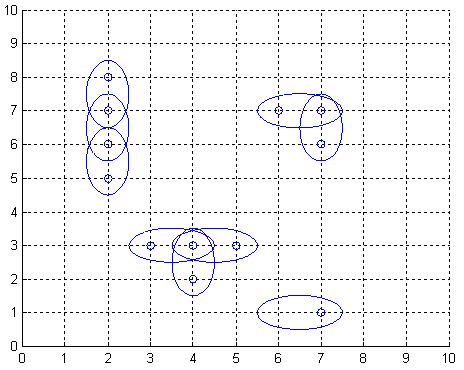Antnna Placement
| Time Limit: 1000MS | Memory Limit: 65536K | |
| Total Submissions: 11093 | Accepted: 5459 |
题目链接:http://poj.org/problem?id=3020
Description:
The Global Aerial Research Centre has been allotted the task of building the fifth generation of mobile phone nets in Sweden. The most striking reason why they got the job, is their discovery of a new, highly noise resistant, antenna. It is called 4DAir, and comes in four types. Each type can only transmit and receive signals in a direction aligned with a (slightly skewed) latitudinal and longitudinal grid, because of the interacting electromagnetic field of the earth. The four types correspond to antennas operating in the directions north, west, south, and east, respectively. Below is an example picture of places of interest, depicted by twelve small rings, and nine 4DAir antennas depicted by ellipses covering them. 
Obviously, it is desirable to use as few antennas as possible, but still provide coverage for each place of interest. We model the problem as follows: Let A be a rectangular matrix describing the surface of Sweden, where an entry of A either is a point of interest, which must be covered by at least one antenna, or empty space. Antennas can only be positioned at an entry in A. When an antenna is placed at row r and column c, this entry is considered covered, but also one of the neighbouring entries (c+1,r),(c,r+1),(c-1,r), or (c,r-1), is covered depending on the type chosen for this particular antenna. What is the least number of antennas for which there exists a placement in A such that all points of interest are covered?
Input:
On the first row of input is a single positive integer n, specifying the number of scenarios that follow. Each scenario begins with a row containing two positive integers h and w, with 1 <= h <= 40 and 0 < w <= 10. Thereafter is a matrix presented, describing the points of interest in Sweden in the form of h lines, each containing w characters from the set ['*','o']. A '*'-character symbolises a point of interest, whereas a 'o'-character represents open space.
Output:
For each scenario, output the minimum number of antennas necessary to cover all '*'-entries in the scenario's matrix, on a row of its own.
Sample Input:
2
7 9
ooo**oooo
**oo*ooo*
o*oo**o**
ooooooooo
*******oo
o*o*oo*oo
*******oo
10 1
*
*
*
o
*
*
*
*
*
*
Sample Output:
17
5
题意:
一根天线可以套住两个各自,问至少需要多少跟天线可以套住所有的‘o’。
题解:
与这道题有类似之处:http://acm.hdu.edu.cn/showproblem.php?pid=4185
考虑二分图匹配,将每个“o”看作一个点,然后挨着的“o”与它相连,二分图匹配的可行性在于一个“o”最多被使用一次。
这里利用贪心的思想,先求出二分图的最大匹配,然后对于没有连到的点单独用一根天线去连,最后直接输出答案即可。
代码如下:
#include <cstdio> #include <cstring> #include <iostream> #include <algorithm> #define mem(x) memset(x,0,sizeof(x)) using namespace std; const int N = 45 ; int map[N][N],check[N*10],match[N*10],vis[N*10],link[N*10][N*10]; int n,m,t,tot,ans,dfn; char s[N]; inline void init(){ mem(map);mem(match);mem(link);mem(check); mem(vis);tot=0;ans=0;dfn=0; } inline void update(int x,int y){ if(map[x+1][y]) link[map[x][y]][map[x+1][y]]=1; if(map[x-1][y]) link[map[x][y]][map[x-1][y]]=1; if(map[x][y+1]) link[map[x][y]][map[x][y+1]]=1; if(map[x][y-1]) link[map[x][y]][map[x][y-1]]=1; } inline int dfs(int x){ for(int i=1;i<=tot;i++){ if(link[x][i] && check[i]!=dfn){ check[i]=dfn; if(!match[i] || dfs(match[i])){ match[i]=x; return 1; } } } return 0; } int main(){ scanf("%d",&t); while(t--){ scanf("%d%d",&n,&m); init(); for(int i=1;i<=n;i++){ scanf("%s",s+1); for(int j=1;j<=m;j++) if(s[j]=='*') map[i][j]=++tot; } for(int i=1;i<=n;i++) for(int j=1;j<=m;j++) if(map[i][j]) update(i,j); for(int i=1;i<=tot;i++){ dfn++; if(dfs(i)) ans++; } for(int i=1;i<=tot;i++) if(match[i]) vis[match[i]]=vis[i]=1; for(int i=1;i<=tot;i++) if(!vis[i]) ans+=2; printf("%d ",ans/2); } return 0; }